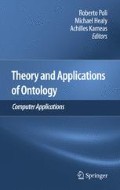Abstract
In recent years, there has been a growing interest in approaches that employ ontological models as theoretical tools for analyzing and improving conceptual modeling languages. In this paper we present a philosophically and cognitively well-founded formal ontology which has been developed with the special purpose of serving as a foundation for general conceptual modeling languages. Furthermore, we demonstrate how this foundational ontology named the Unified Foundational Ontology (UFO) has been used to evaluate and redesign the metamodel of the Unified Modeling Language (UML) for the purpose of conceptual modeling.
Access this chapter
Tax calculation will be finalised at checkout
Purchases are for personal use only
Notes
- 1.
Red is used here as an object universal whose instances are particulars like a red apple x, not as a quality universal whose instances are particulars such as the specific redness of x (Guizzardi, 2005).
- 2.
A relational image function is formally defined as follows: Let R be a binary relation defined for the two sets X and Y. The function Im with signature Im(_,_): \({\textbf{X}}\, \times ({\textbf{X}} \Leftrightarrow {\textbf{Y}}) \boldsymbol{\to \wp} ({\textbf{Y}})\) is defined as \({\textbf{Im}}({\textbf{x}}{\textrm{,}}{\textbf{R}}) = \left\{ {{\textbf{y}}|({\textbf{x,y}}) \in {\textbf{R}}} \right\}\).
References
Breu, R., U. Hinkel, C. Hofmann, C. Klein, B. Paech, B. Rumpe, and V. Thurner. 1997. Towards a formalization of the unified modeling language. In Proceedings of the 11th ECOOP, Jyväskylä, Finland.
Ferrario, R., and A. Oltramari. 2004. Towards a computational ontology of the mind. In Proceedings of the 3rd International Conference on Formal Ontology in Information Systems (FOIS), Torino, Italy.
Gärdenfors, P. 2000. Coneptual spaces: The gemetry of thought. Cambridge, MA: MIT Press.
Grice, H.P. 1975. Logic and conversation. In Syntax and semantics: vol 3. Speech acts, eds P. Cole and J. Morgan, 43–58. New York, NY: Academic Press.
Guizzardi, G. 2005. Ontological foundations for structural conceptual models, PhD Thesis, University of Twente, The Netherlands.
Guizzardi, R.S.S., and G. Guizzardi. 2011. Ontology-based transformation framework from TROPOS to AORML. In Social modeling for requirements engineering, Cooperative Information Systems Series, eds. P. Giorgini, N. Maiden, J. Mylopoulos, and E. Yu, Cambridge, MA: MIT Press, 547–570.
Guizzardi, G., R. Falbo, and R.S.S. Guizzardi. 2008. Grounding software domain ontologies in the unified foundational ontology (UFO): The case of the ODE software process ontology. In Proceedings of the 11th Iberoamerican Conference on Software Engineering, Recife, Brazil.
Guizzardi, G., and Wagner, G. 2005. On a unified foundational ontology and some applications of it in business modeling. In Ontologies and business systems analysis, eds. M. Rosemann, and P. Green. Hershey, PA: IDEA Publisher.
Heller, B., and H. Herre. 2004. Ontological categories in GOL. Axiomathes 14:71–90.
Lowe, E.J. 2006. The four category ontology. Oxford: Oxford University Press.
Masolo, C., S. Borgo, A. Gangemi, N. Guarino, and A. Oltramari. 2003. Ontology library, WonderWeb Deliverable D18.
Masolo, C., G. Guizzardi, L. Vieu, E. Bottazzi, and R. Ferrario. 2005. Relational roles and qua individuals. In AAAI Fall Symposium on Roles, an Interdisciplinary Perspective, Virginia.
Object Management Group. 2003. UML 2.0 superstructure specification, Doc.# ptc/03-08-02, Aug 2003.
Schneider, L. 2002. Formalised elementary formal ontology, ISIB-CNR Technical Report 03/2002. http://www.loa-cnr.it/Publications.html
Smith, B., and K. Mulligan. 1986. A relational theory of the act. Topoi 5(2):115–130.
Author information
Authors and Affiliations
Corresponding author
Editor information
Editors and Affiliations
Rights and permissions
Copyright information
© 2010 Springer Netherlands
About this chapter
Cite this chapter
Guizzardi, G., Wagner, G. (2010). Using the Unified Foundational Ontology (UFO) as a Foundation for General Conceptual Modeling Languages. In: Poli, R., Healy, M., Kameas, A. (eds) Theory and Applications of Ontology: Computer Applications. Springer, Dordrecht. https://doi.org/10.1007/978-90-481-8847-5_8
Download citation
DOI: https://doi.org/10.1007/978-90-481-8847-5_8
Published:
Publisher Name: Springer, Dordrecht
Print ISBN: 978-90-481-8846-8
Online ISBN: 978-90-481-8847-5
eBook Packages: Humanities, Social Sciences and LawPhilosophy and Religion (R0)

